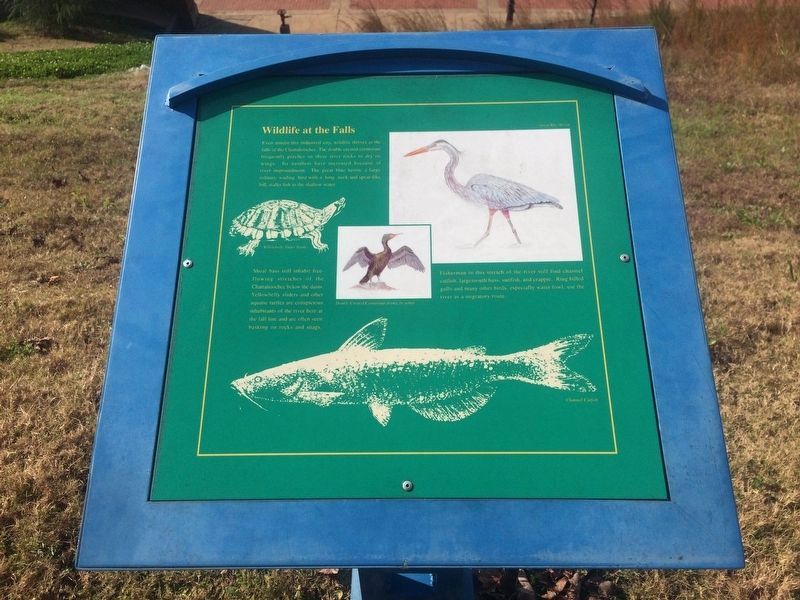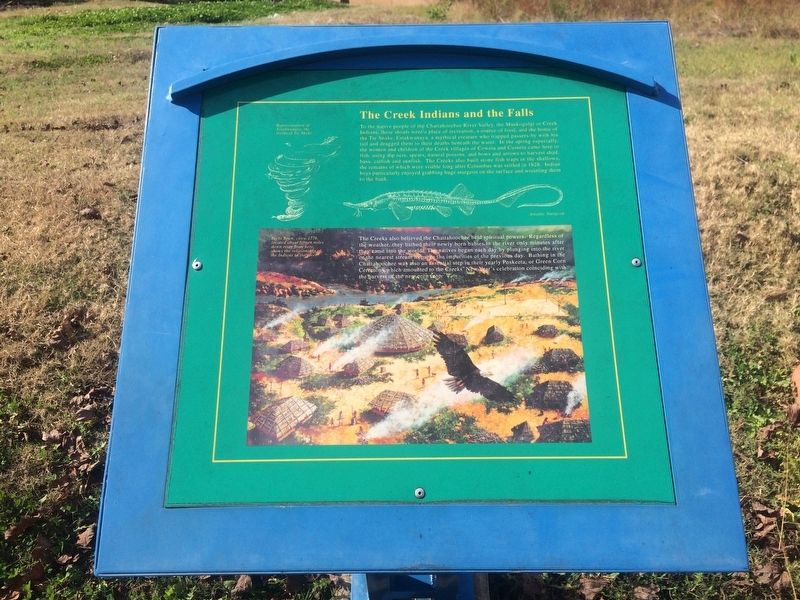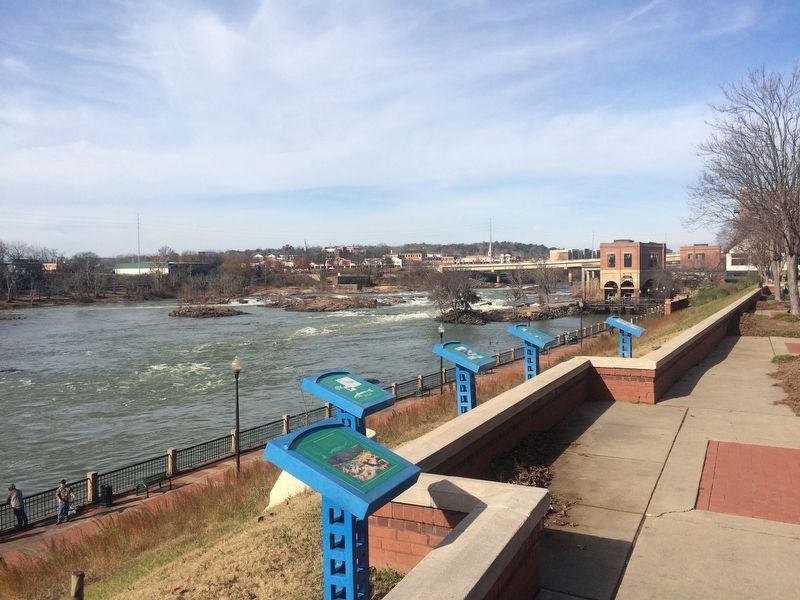Columbus in Muscogee County, Georgia — The American South (South Atlantic)
The Creek Indians and the Falls
The Creek Indians and the Falls
To the native people of the Chattahoochee River Valley, the Muskogulgi or Creek Indians, these shoals were a place of recreation, a source of food, and the the home of the Tie Snake, Estakwanaya, a mythical creature who trapped passers-by with his tail and dragged them to their deaths beneath the water. In the spring especially, the women and children of the Creek villages of Coweta and Cusseta came here to fish, using dip nets, spears, natural poisons, and bows and arrows to harvest shad, bass, catfish and sunfish. The Creeks also built stone fish traps in the shallows, the remains of which were visible long after Columbus was settled in 1828. Indian boys particularly enjoyed grabbing huge sturgeon on the surface and wrestling them to the bank.
The Creeks also believed the Chattahoochee held spiritual powers. Regardless of the weather, they bathed their newly born babies in the river only minutes after they came into the world. The natives began each day by plunging into the river or the nearest stream to purge the impurities of the previous day. Bathing in the Chattahoochee was also an essential step in their yearly Poskeeta, or Green Corn Ceremony which amounted to the Creeks New Year’s celebration coinciding with the harvest of the new corn crop.
Captions:
Representation of Estakwanaya, the mythical Tie Snake
Atlantic Sturgeon
Yuchi Town, circa 1776, located about fifteen miles down river from here, shows the relationship of the Indians to the river.
Topics. This historical marker is listed in these topic lists: Anthropology & Archaeology • Native Americans. A significant historical year for this entry is 1828.
Location. 32° 28.02′ N, 84° 59.762′ W. Marker is in Columbus, Georgia, in Muscogee County. Marker is on Bay Avenue north of 11th Street, on the left when traveling north. Touch for map. Marker is in this post office area: Columbus GA 31901, United States of America. Touch for directions.
Other nearby markers. At least 8 other markers are within walking distance of this marker. Cotton Warehouses (here, next to this marker); The Fall Line (here, next to this marker); The Dam (1882) & Powerhouses (1899) (a few steps from this marker); The Ledger-Enquirer Newspapers (about 800 feet away, measured in a direct line); W. C. Bradley and Coca-Cola (approx. 0.2 miles away); City of Columbus (approx. 0.2 miles away); The Tie-Snake (approx. 0.2 miles away in Alabama); Nehi and Royal Crown Cola (approx. 0.2 miles away). Touch for a list and map of all markers in Columbus.

Photographed By J. Makali Bruton, December 25, 2017
3. This additional marker, "Wildlife at the Falls", is to the right of the featured marker
Wildlife at the Falls
Even amidst this industrial city, wildlife thrives at the falls of the Chattahoochee. The double crested cormorant frequently perches on these river rocks to dry its wings. Its numbers have increased because of river impoundment. The great blue heron, a large solitary, wading bird with a long neck and spear-like bill, stalks fish in the shallow water.
Shoal bass still inhabit free-flowing stretches of the Chattahoochee below the dams. Yellowbelly sliders and other aquatic turtles are conspicuous inhabitants of the river here at the fall line and are often seen basking on rocks and snags.
Fisherman in this stretch of the river still find channel catfish, largemouth bass, sunfish and crappie. Ring billed gulls and other birds, especially water fowl, use the river as a migratory route.
Captions:
Great Blue Heron
Yellowbelly Slider Turtle
Double Crested Cormorant drying its wings
Channel Catfish
Even amidst this industrial city, wildlife thrives at the falls of the Chattahoochee. The double crested cormorant frequently perches on these river rocks to dry its wings. Its numbers have increased because of river impoundment. The great blue heron, a large solitary, wading bird with a long neck and spear-like bill, stalks fish in the shallow water.
Shoal bass still inhabit free-flowing stretches of the Chattahoochee below the dams. Yellowbelly sliders and other aquatic turtles are conspicuous inhabitants of the river here at the fall line and are often seen basking on rocks and snags.
Fisherman in this stretch of the river still find channel catfish, largemouth bass, sunfish and crappie. Ring billed gulls and other birds, especially water fowl, use the river as a migratory route.
Captions:
Great Blue Heron
Yellowbelly Slider Turtle
Double Crested Cormorant drying its wings
Channel Catfish
Credits. This page was last revised on January 4, 2018. It was originally submitted on January 4, 2018, by J. Makali Bruton of Accra, Ghana. This page has been viewed 549 times since then and 55 times this year. Photos: 1, 2, 3. submitted on January 4, 2018, by J. Makali Bruton of Accra, Ghana.

